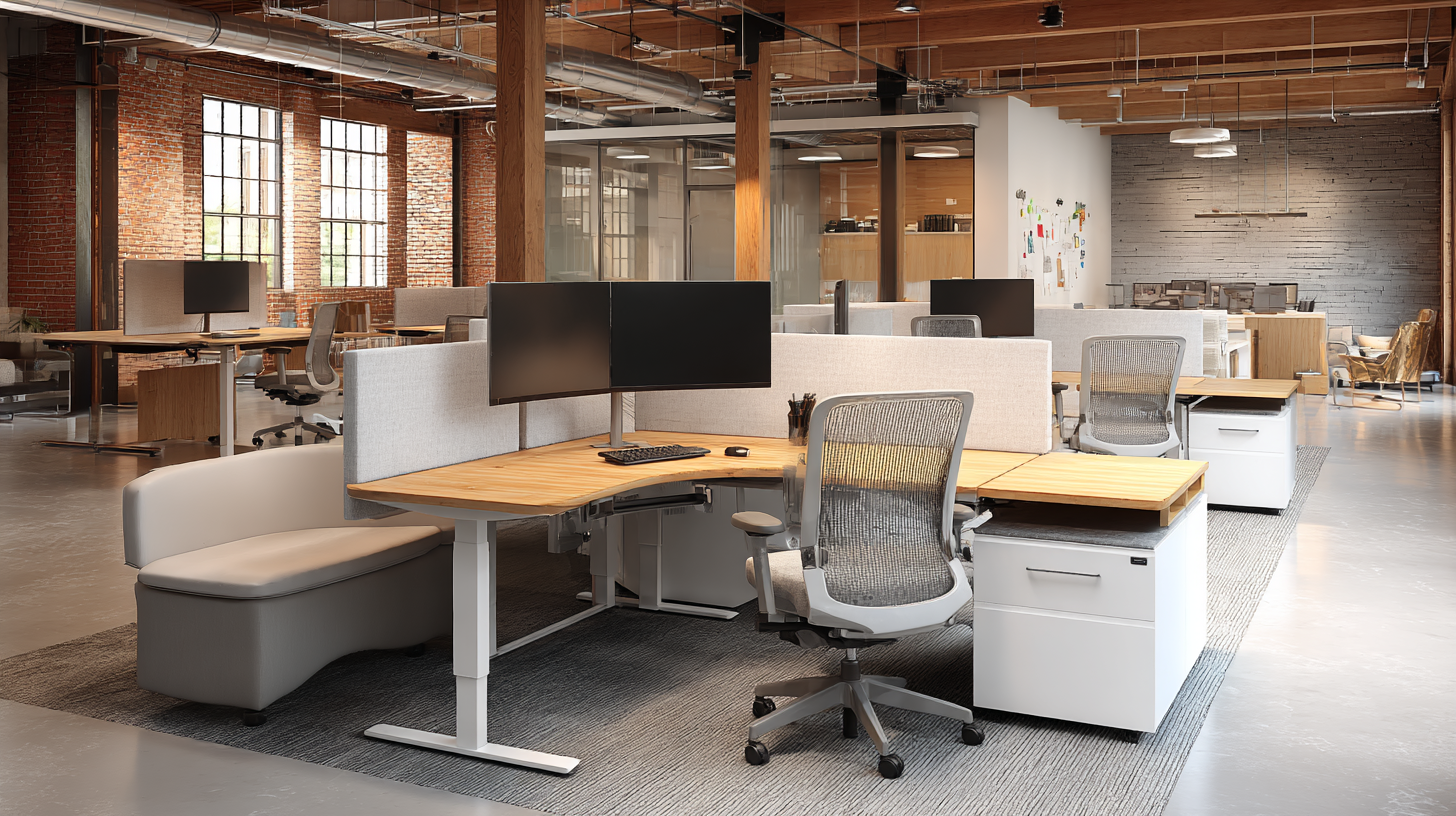5 Compelling Reasons to Choose Best Ergonomic Furniture for Global Procurement Success
As we approach the technological advancements of 2025, the focus on enhancing workplace productivity and employee well-being has never been more critical. One of the most significant aspects influencing these improvements is the adoption of ergonomic furniture. Ergonomic furniture is designed not only to provide comfort but also to promote healthy posture and reduce the risk of musculoskeletal disorders among employees. In an era where global procurement success hinges on maximizing efficiency and ensuring employee satisfaction, incorporating ergonomic furniture becomes essential. This blog will explore five compelling reasons why investing in high-quality ergonomic furniture can significantly contribute to achieving organizational goals and fostering a productive work environment in a rapidly evolving technological landscape.

The Importance of Ergonomic Furniture in Global Procurement Strategies
In today’s fast-paced business environment, the importance of ergonomic furniture in global procurement strategies cannot be overstated. As companies expand their operations across borders, maintaining employee productivity and health becomes crucial. Ergonomic furniture not only enhances comfort but also minimizes the risk of work-related injuries, ultimately leading to a more engaged and efficient workforce. Companies that prioritize ergonomic designs in their procurement processes often see lower absenteeism rates and higher overall satisfaction among their employees.
When selecting ergonomic furniture, it’s essential to consider the diverse needs of a global workforce. Tips for successful implementation include conducting regular assessments to understand specific comfort requirements of different teams. Additionally, investing in adjustable furniture solutions allows employees to customize their workstations, fostering a more inclusive work environment that caters to various body types and preferences.
Integrating ergonomic principles into procurement strategies also aids in attracting top talent. A workplace that prioritizes employee well-being signals to potential hires that the company values their health and productivity. By incorporating ergonomic furniture, organizations not only enhance employee welfare but also strengthen their brand reputation within increasingly competitive markets.

Key Features to Look for When Selecting High-Quality Manufacturers
When selecting high-quality ergonomic furniture manufacturers for global procurement, it’s essential to focus on key features that ensure durability, comfort, and compliance with industry standards. According to a report by the Global Ergonomics Industry, incorporating ergonomic solutions can lead to a 25% reduction in workplace-related injuries, significantly enhancing productivity. Therefore, manufacturers should be evaluated based on their adherence to ergonomic design principles, materials used, and customer feedback.

Additionally, consider the manufacturer's certifications and compliance with international standards such as ISO 9001 and ANSI/BIFMA. These certifications indicate a commitment to quality and safety, essential for any global procurement strategy. Research from the International Association for Human Factors and Ergonomics shows that companies investing in ergonomically designed furniture experience a 15% increase in employee satisfaction. Prioritizing manufacturers that demonstrate these features not only fosters a healthier work environment but also drives long-term success in global operations.
How Ergonomic Solutions Enhance Employee Well-Being and Productivity
Ergonomic furniture has become increasingly vital for organizations aiming to enhance employee well-being and productivity. Research indicates that implementing ergonomic solutions can lead to a 25% reduction in employee discomfort and a staggering 40% increase in productivity. This correlation stems from the fact that ergonomic chairs and desks promote better posture, reduce strain on the body, and allow employees to work in comfort for extended hours. A recent study published in the "Journal of Occupational Health Psychology" revealed that employees equipped with ergonomic furniture reported significantly higher job satisfaction and lower absenteeism rates due to health issues.
To maximize the benefits of ergonomic furniture, organizations should consider integrating height-adjustable desks into their workplaces. These allow employees to alternate between sitting and standing, which not only fosters physical health but also enhances mental alertness. Additionally, investing in ergonomic accessories—like keyboard trays and monitor stands—can further reduce the risk of repetitive strain injuries, leading to healthier, more engaged employees.
Another effective tip is to encourage regular breaks that promote movement and stretching. Research from the American Journal of Preventive Medicine found that short breaks every hour can dramatically improve concentration and energy levels. By fostering an environment that prioritizes ergonomic solutions, companies can significantly boost their overall productivity and employee satisfaction, paving the way for global procurement success.
Impact of Ergonomic Furniture on Employee Well-Being and Productivity
Evaluating Supplier Certifications and Compliance in Ergonomic Furniture
When it comes to global procurement of ergonomic furniture, supplier certifications and compliance play a crucial role in ensuring both quality and safety. According to a report by the Global Center for Business and the Environment, ergonomic furniture can boost productivity by up to 25%, making it essential for organizations to partner with certified suppliers who adhere to industry standards. Certifications such as BIFMA (Business and Institutional Furniture Manufacturers Association) and ISO (International Organization for Standardization) not only provide assurance regarding product safety and performance but also underscore a supplier's commitment to sustainability and quality manufacturing practices.
Moreover, compliance with regulations, such as the Occupational Safety and Health Administration (OSHA) guidelines, is vital for minimizing workplace injuries associated with poor ergonomics. A study by the National Institute for Occupational Safety and Health (NIOSH) found that ergonomics-related injuries can account for up to 31% of all workplace injuries. By sourcing from suppliers who prioritize compliance and possess the necessary certifications, businesses can mitigate risks and create a safer, more productive environment for their workforce. As the demand for ergonomic solutions grows, selecting compliant suppliers becomes not just a preference but a necessity for long-term procurement success.
5 Compelling Reasons to Choose Best Ergonomic Furniture for Global Procurement Success
| Reason | Benefit | Supplier Certification | Compliance Standard |
|---|---|---|---|
| Improved Productivity | Increased focus and work output | ISO 9001 | Quality Management Systems |
| Enhanced Employee Well-being | Reduced musculoskeletal disorders | ANSI/BIFMA | Furniture Safety Standards |
| Long-term Cost Savings | Less expenditure on healthcare | FSC Certification | Sustainable Forestry Practices |
| Customization Options | Tailored solutions for diverse needs | CE Marking | European Safety Standards |
| Positive Corporate Image | Attracting top talent | Greenguard Certification | Low Chemical Emissions |
Cost-Benefit Analysis: Investing in Ergonomic Furniture for Long-Term Success
Investing in ergonomic furniture is more than just a trend; it’s a strategic choice for companies aiming for long-term success. According to a report by the Global Wellness Institute, businesses can save up to $30 for every $1 invested in ergonomic improvements. This substantial return highlights the importance of creating a healthy workspace that enhances employee well-being and productivity. A study from the Occupational Safety and Health Administration (OSHA) suggests that ergonomic interventions can decrease work-related injuries by up to 50%, ultimately leading to reduced healthcare costs and worker compensation claims.
Moreover, the integration of ergonomic furniture into the workplace significantly impacts employee satisfaction and retention. Research conducted by the American Society of Interior Designers indicates that employees are 33% more satisfied with their jobs when provided with ergonomically designed furniture. In an era where turnover can cost companies up to 200% of an employee’s salary, investing in ergonomic solutions proves to be a viable cost-benefit strategy. As organizations increasingly recognize the link between comfort, productivity, and employee morale, incorporating high-quality ergonomic furniture is essential for global procurement success.
